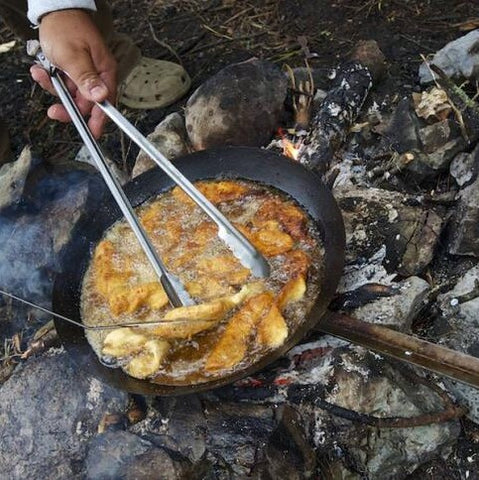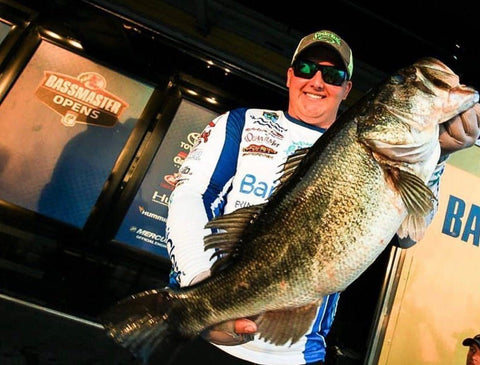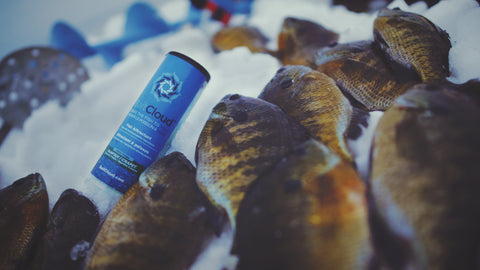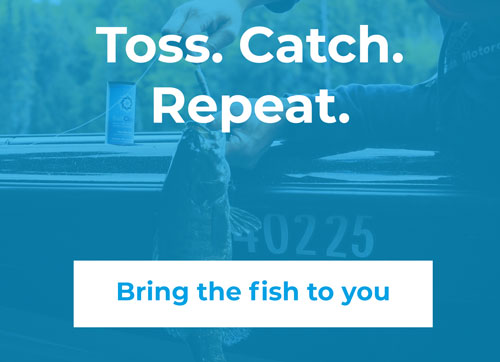9 Tips for the Perfect Shore Lunch
How to take your camp-cooked fish feasts to the next level. Whether you are planning a week-long backcountry trip or a quick meal down at your favorite fishing hole, here are a few tips to help you make the most of your fish dinner, right on the bank.
1. KEEP YOUR FISH FRESH UNTIL YOU ARE READY TO COOK.
We kept our eating fish on a stringer, either rope-style or metal clip, in the water right until we were ready to skin them. Clear, cold waters kept them fresh and lively all day. If you are fishing in a warmer climate, make sure your fish can reach water a foot or two deep to stay cooler. Keep them in a shady spot whenever possible. Don't have access to cool water but do have a cooler full of ice? Gut your fish immediately and put them on ice to chill.
2. PACK A CUTTING BOARD.
Fileting fish on a boat paddle or a flat rock is OK, but a cutting board makes the job way easier. Space tight? Try a thin plastic mat that can roll up. Or a folding board,
3. WATER AND FISH BREADING DON’T MIX.
Use a vacuum sealer to bag up one meal’s worth of your favorite fish breading. That cuts down on the packaging you have to carry in and out and assures that your breading will be dry when you are ready to use it. Side dishes like packaged rice or mashed potatoes get the same treatment so they won’t get wet in the event of a rainstorm or a canoe tipping.
4. SPLURGE FOR A NORMAL-SIZED SKILLET.
If you plan to cook for a crowd, a small backpacking skillet isn’t big enough to get the job done. Pack in a full-sized aluminum skillet. I like a non-stick version from a restaurant supply store for toughness and easy clean-up.
5. DON’T BE AFRAID TO COOK A FISH WHOLE.
Fillets are nice, but there's a lot of waste compared to cooking a whole fish. Cheeks (no lie, the cheek meat is the best part of a big fish), the throat saddle and the belly all make fine eats. Is the fish too big to fit in your skillet? Cut it in half or even into thirds. Score the meat over the thickest areas to allow the fish to cook faster and make eating easier.
6. PACKAGE YOUR OIL IN A METAL OR TOUGH PLASTIC BOTTLE WITH A SCREW-ON LID.
Plastic oil bottles from the store are easy to crush. And that’s a mess no one wants to clean up. Pour your needed oil into a drink bottle with a tight-fitting lid to keep it from getting smashed.
7. DON’T LIMIT YOURSELF TO FRIED FISH.
There's nothing wrong with fried fish. We ate it for several meals on our trip, but there are other ways to prepare fish that are just as good. Try blackening, and pack along your favorite flour or corn tortillas for fish tacos. The tortillas don’t take up much room in your pack and they won’t smash like a loaf of bread.
8. PACK ALONG SOME SQUEEZE BUTTER.
You will never find margarine in my refrigerator at home. Real butter tastes better, cooks better and is better for you. But a tub of squeeze margarine on a camping trip is admittedly handy. Squeeze a little on your fish to make your blackening seasoning hold tight and keep your fish from sticking to the skillet. Want grilled fish? Pack along some heavy-duty foil to lay on the grill, then add a bit of squeeze margarine to keep the fish from sticking. It comes in handy for side dishes like mashed potatoes, too.
9. STOCKPILE PLENTY OF WOOD.
If you are cooking over an open fire, stock up on thumb to wrist-sized pieces of firewood before you start cooking. Small pieces like this make maintaining the proper frying temperature easier than using large chunks. Be careful while feeding the fire. Tall flames lapping up and over the side of your skillet will start a grease fire that means dinner will be late, at best, and lost to a forest fire on the bad end.
How do you know when your grease is hot enough? Add a small piece of fish while the oil heats. When it starts to pop and sizzle, you are ready to start cooking. If you have the space, you can always pack in a handful of popcorn. Drop a few kernels into the oil. When they pop, your oil is hot enough to fry.
If you start using these tips, be ready. Your fishing buddies might just make you full-time camp cook. Just make sure they do the dishes. And bring BaitCloud so there are plenty of fish to cook up!






